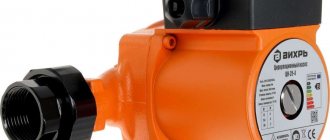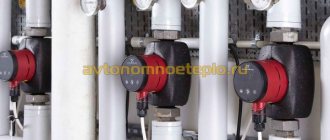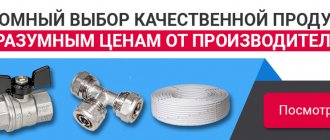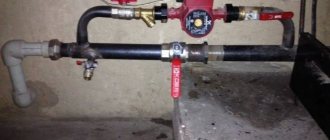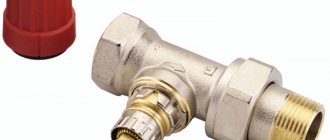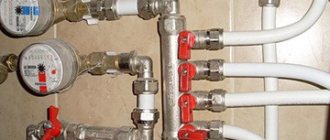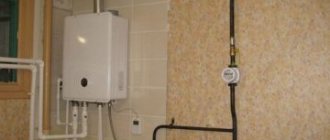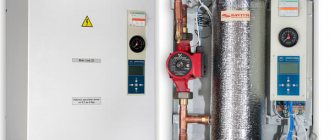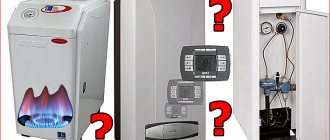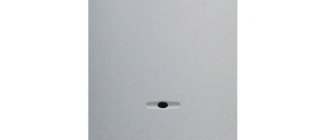How to choose a pump for a well? There are many nuances in this matter, and it is simply impossible to unequivocally recommend a pump that is ideal in all respects. Since there are no universal pumps, let’s consider the general principle of their selection based on a number of characteristics: 1. Head (pressure) 2. Well 3. Pressure-flow characteristics of the pump 4. Resistance 5. Connection diagrams.
Each of these parameters is important, and ignoring at least one of them when choosing a pump can lead to problems when connecting it.
Pump selection by pressure
The pumps have markings that look something like this: SQ 1-30; SQE 2-85, etc. In this case, the numbers that are of interest are the rated operating characteristics of the pump. Thus, the SQ 1-30 indicator indicates that the pump’s performance is 1 cubic meter of water at a pressure of 30 meters. But why is pressure indicated in meters and not bars?
Before choosing a well pump, you should determine the depth at which the water is located, and then calculate the height to which it needs to be raised into the house. Let's assume that the desired pressure in the tap of a private house is 2.5 bar, and adequate pressure is required. A column of water 10 m high presses 1 cm2 with a weight of 1 kg, which is almost equal to the pressure of 1 atmosphere, 1 bar or 10 meters of water column. Therefore, to raise water to the 3rd floor, it is necessary to create a pressure of at least 1 bar. Since the pump struggles with the weight of the water column in meters, you can use its markings and determine how many meters the water will rise. If you need to find out the pressure in bar, simply divide the indicated number by 10.
At the next stage, find out the water consumption by the marking on the water supply device. Let's say a tap needs to fill a 12-liter bucket of water in 1 minute. Simultaneously operating faucets in the kitchen and shower should also cope with this task in a minute, and a washing machine and toilet will require approximately the same amount of water, in total – at least 36 liters, or 2 m3/hour. But all these points are unlikely to work at the same time. As a rule, the maximum simultaneous activation is a shower, washing machine and kitchen sink, which gives a consumption of 1.5 buckets of water, or 1 m3/hour.
Let's summarize:
• Pump pressure is measured in meters, not bars • Convert if necessary • Find out the water flow in your system
Rating of household surface equipment
- Aquario ARM-100
- this model has excellent efficiency and a long service life with minimal characteristics. - Gilex Jumbo 60/35 HK
- pump, consuming 600 W, produces a pressure of up to 35 m. - Wilo PB-088EA
- the unit has a power consumption of 140 W, but a head of 9 m.
Two types of units are used:
- single-stage centrifugal pumps;
- multistage centrifugal pumps.
The design is selected taking into account the performance characteristics and scope of use.
Characteristics:
- Compact drive, ensuring low noise level during operation.
- Fluid consumption. Maximum performance – 70 l/min.
- Fluid pressure (maximum) – 17 m.
- Minimum power – from 500 W.
Advantages:
- long continuous operation;
- ease of installation;
- affordable price;
- small dimensions.
Minuses:
- liquid suction height 7-9 m;
- pumping distance – 17-42 m.
Well
For each pump model, the permissible values of foreign inclusions in the water (sand, etc.) are established. Failure to comply with the requirements leads to rapid wear and tear of the device and will void the warranty. Therefore, before selecting or buying a well pump, it is necessary to pump the well and do a water analysis.
A well is a round deep hole of small diameter with a pipe inside forming the walls. At a certain height, the pipe walls have holes, the so-called filter. There is a column of water in the well.
Before choosing a pump, find out:
• Static water level • Dynamic water level • Well flow rate
These characteristics play a key role when choosing a well pump. It is necessary to determine at what depth the water mirror, or that same static level, is located. It is called so because the water at the moment of measurement is in a calm position.
When the pump is turned on, the static level will decrease to the dynamic level: the water cannot fall below the dynamic level. The difference between the statistical and dynamic volumes of a well is called flow rate.
Important: the pump should not pump out more than the well can produce. Thus, a pump power of 3 m3/hour is absolutely not suitable for a well with a flow rate of 1.5 m3. Ideally, the pump should be slightly weaker than the well flow rate, by about 20-30%.
Find out at what depth the well filter is located. The pump should be positioned 1 m below the dynamic water level and 1 meter above the well filter. This data is usually indicated in the well passport.
So
• Static level – depth of the water surface at rest; • Dynamic level – minimum depth of the water surface; • Flow rate – volume of water (measured in liters per minute or cubic meters per hour)
Firstly
The starting point when selecting a circulation pump for a heating system is the building's heat demand, calculated for the coldest time of year.
In professional design, this indicator is determined on a computer. It can be approximately calculated based on the area of the heated room. According to European standards, heating 1 sq.m in a house with 1-2 apartments requires 100 W, and for apartment buildings 70 W. If the condition of the building does not meet the standards, the designer takes into account a higher specific heat consumption. For residential buildings with improved thermal insulation and industrial premises, 30-50 W/sq.m. is required.
In Russia, similar standards for houses with 1-2 apartments have not yet been defined. SNiP 2.04.07-86* “Heating networks” recommends calculating the maximum heat flow for heating 1 sq.m of total area of residential buildings built since 1985 according to new standard designs, according to the following aggregated indicators:
- for 1-2-story buildings: -173 W/sq.m at a design outdoor temperature of -25C and 177 W/sq.m at -30C;
- for 3-4-story buildings: 97 and 101 W/sq.m., respectively.
According to SNiP 2.04.05-91* “Heating, ventilation and air conditioning”, the estimated outdoor air temperature in Moscow is -26 degrees C. Using the interpolation method, we find that in the capital the specific heat demand of 1-2 storey residential buildings is 173.8 W/sq. .m, and 3-4 storeys - 97.8 W/sq.m.
Pressure and flow characteristics of the pump
Each pump has a pressure-flow characteristic, which looks like this: SQ 1-50, 50 Hz. When choosing a pump for a well, you should definitely study its pressure-flow graph. The specifications may indicate both maximum and nominal performance characteristics, so the graph will provide the most complete information. If such information is not in the pump passport, check it on the pump manufacturer’s website. The highest efficiency of any pump is approximately in the middle of the graph. If the value deviates greatly, the service life of the device can be significantly reduced.
Remember:
• Each pump is supplied with a pressure-flow characteristic in the form of a graph; • Optimal performance is approximately in the middle of the schedule.
How to choose surface water equipment
Main parameters:
- Depth of water rise. Measure the distance from the suction pipe to the surface of the liquid surface.
- Pressure The parameter indicates the maximum water transmission range. The length of the water supply pipes or irrigation system is taken into account.
- Engine power. With increasing power, the pressure and lifting depth increase.
- Electrical energy consumption.
- Material. Only high-quality components (bearings, blades) will withstand intense work.
- Noisy running pump.
- Safety. The parameters include: ease of installation, tightness, quality of pump assembly.
- Service maintenance. If there is no service center in the region to service the selected model, then difficulties will arise with warranty repairs in the event of a breakdown and with the purchase of spare parts.
Secondary parameters:
- Brand name. You don’t have to overpay for a well-known name. There are several well-known brand companies in the segment of surface pumps, but only new manufacturers have proven themselves well.
- Price. You need to choose a pump based on balanced characteristics.
Resistance
In addition to the need to push water to a certain height, the pump must be able to overcome the resistance created in the pipeline. A pipe that is too narrow will increase resistance and system performance will decrease, while a pipe that is too wide will require unnecessary costs. The diameter of the water conduit should be optimally selected to avoid unnecessary resistance.
To calculate the resistance, check out the pressure loss graph for a pipe of a specific type and diameter: this way you can calculate the losses for a certain volume of water. If there is no graph or you don’t want to count, use the simple recommendation below:
Recommended HDPE pipe diameter:
- flow up to 1.5 m3/hour – 25 mm
- flow up to 3 m3/hour – 32 mm
Rating of surface units for hot water
- CNS (G)
- the line of units refers to multistage pumps. The water temperature range is from 45 degrees (CNS) to 105 degrees (CNSG). Pressure indicators – 44-220 m, liquid supply – 38 m3/h. - WILO Yonos
- the household model has a “wet” rotor, which provides a lifting height of 7 m and an adjustable power level. - WILO VeroTwin
– model with a “dry” rotor, index DR-E, temperature range – 120 degrees at high pressure.
Circulating units are used to pump hot liquid. The heating and hot water supply system will require a closed circuit.
Many pumps are made of high-quality cast iron, and the insulating elements are made of ceramics or elastic materials.
For pumps with a “wet” rotor, the coolant is moving water.
And equipment with a “dry” rotor has an isolated power part from the movable pressure mechanism.
Advantages:
- Pumps with a “wet” rotor are characterized by smooth pressure control, reliable operation and low noise.
- Equipment with a dry rotor has an efficiency of up to 80% and high productivity.
Flaws:
- Inexpensive pumps have an efficiency of no more than 50%.
- Expensive equipment requires periodic maintenance.
Connection diagram
Before describing the connection diagrams, let us recall such important characteristics of the pump as power; diameter; the possibility of soft start or the possibility of electronic control of the shaft speed; resistance to voltage surges; minimum and maximum immersion depth; pump diameter. Thus, the diameter of the pump is directly related to the price of the well: the smaller the diameter of the pump, the smaller the diameter of the pipe, which means its drilling will be cheaper.
The pump is connected through a pressure switch or through an automatic flow switch. Knowing the characteristics of the system and the pump, i.e. pressure and power that your relay will have to open, you can optimally select the right relay for the pump.
Some pump models provide protection against overheating and dry-running protection, but this is of an emergency nature only. When installing the system, it is worthwhile to provide your own dry-running protection system.
The disadvantage of systems that work with a pressure switch: between starts and stops of the pump, the pressure will always change, which will cause discomfort in using water in the shower. To avoid such inconvenience, you can purchase a pump with a frequency converter.
Pay attention to the maximum immersion depth of the pump: excessive depth will lead to pump failure.
Audit of industrial water supply systems
Pumps used in closed circulation systems can operate virtually uninterrupted, and often operate around the clock. At any production there are technical personnel responsible for the trouble-free operation of the pumps, who must carry out daily inspections.
- It is necessary to constantly monitor the smooth start-up and operation of the mechanism, identify vibrations and beating in the unit or pipeline. The main attention is paid to the condition of flange connections and couplings, mounting the unit on the foundation, lubrication of oil seals and the temperature of pump bearings. High-quality lubrication is very important for them - the oil is changed at the time specified by the manufacturer.
Monitoring the condition of pumping equipment in production
- Most often, the scheme is as follows: the first cleaning of the bearings with an oil change occurs quite quickly, after two hundred hours of pump operation. The next replacement can be made after two thousand hours of operation - this is approximately once a year. The higher the quality of the oil, the longer this period can be.
- During operation of the unit, some parts wear out faster than others, and this is normal. Much depends on the temperature of the pumped liquid, the presence of abrasive impurities in it, and the level of vacuum in the suction part. First of all, bushings and sealing rings and stuffing box become unusable.
- The manufacturer allots a certain period of time for their operation, after which, without waiting for a breakdown, the pump must be sent for major repairs. After the audit, control tests are carried out, based on the results of which the unit can be reintroduced into the system.
The timing of inspections and overhauls of pumping equipment is established according to the actual operating conditions of the pumps, but taking into account the manufacturer’s recommendations. In production, an inspection log is kept for each unit, where the readings of instrumentation, the condition of the main components and the dates of equipment maintenance are recorded.
Conclusion
• Pressure is calculated in meters: 10 m water column = 1 bar. • Flow is measured in m3/hour (less often - l/min). • The pressure-flow characteristic is a graph that allows you to determine whether a pump is suitable for a particular well. • Well: static water level – depth of the water surface in a calm state; dynamic level - the depth below which water theoretically cannot fall; flow rate is the volume of water that a well can produce per hour. • Pipe: use the maximum permissible pipe diameter to reduce resistance • Observe the maximum and minimum pump immersion depth requirements.
Following these recommendations will allow you to independently select a well pump that is optimally suitable for inclusion in the system.
Rating of automatic surface units
- Speroni KPM 50
- the model is equipped with strong, durable parts, operating noise is minimal. - RSM 5GA
- a productive model designed to regulate internal fluid pressure. - Marina KPM 50
– the equipment is highly economical.
Automatic watering is needed if an autonomous liquid supply system is installed and an irrigation system is connected. The functions of the control programs ensure an excellent end result.
A special feature of the operation of these pump models is their interaction with automatic installations. They contain:
- branched pipelines;
- control units;
- irrigation equipment;
- valves
The task of an automatic surface pump is to continuously supply liquid when the unit is turned on autonomously and replenish water reserves to the required level.
When choosing a pump, take into account the following characteristics:
- Quantity (volume) of pumped liquid.
- The quality and degree of contamination of pumped water, depending on the type of water source.
- Lifting height: from 5 to 10 m.
- Developed pressure.
In practice, two types of units are used - centrifugal and piston.
Advantages:
- provide high pressure at constant flow;
- efficiency during long-term operation.
The performance of these pumps depends on the operation of the start-stop system.
Methods for calculating dependencies between water flow and pipeline diameter
Using the formulas below, you can both calculate the water flow in the pipe and find the dependence of the pipe diameter on the water flow.
In this water consumption formula:
- under q the flow rate in l/s is taken,
- V – determines the speed of hydraulic flow in m/s,
- d – internal section (diameter in cm).
Knowing the water flow and d cross-section, you can use reverse calculations to set the speed, or, knowing the flow and speed, determine the diameter.
If there is an additional supercharger (for example, in multi-storey buildings), the pressure it creates and the speed of the hydraulic flow are noted in the device passport. Without additional injection, the flow speed very often changes in the range of 0.8-1.5 m/sec.
For more accurate calculations, head losses are taken into account using the Darcy formula:
To calculate, you need to additionally install:
- pipeline length (L),
- loss indicator, which depends on the roughness of the pipeline walls, turbulence, curvature and sections with shut-off valves (?),
- fluid viscosity (?).
The relationship between the value D of the pipeline, the speed of the hydraulic flow (V) and the water consumption (q) taking into account the slope angle (i) can be expressed in a table where two known quantities are connected by a straight line, and the value of the desired quantity will be visible at the intersection of the scale and the straight line.
For technical justification, graphs of the dependence of operating and capital costs are also drawn with the determination of a favorable value of D, which is mounted at the intersection point of the operating and capital cost curves.
Calculation of water flow through a pipe taking into account the pressure drop can be carried out using online calculators (for example: https://allcalc.ru/node/498; https://www.calc.ru/gidravlicheskiy-raschet-truboprovoda.html).
For hydraulic calculation, as in the formula, it is necessary to take into account the loss indicator, which implies the choice:
- method for calculating resistance,
- material and type of pipeline systems (steel, cast iron, asbestos cement, composite material of concrete and steel, plastic), where it must be taken into account that, for example, plastic surfaces are less rough than steel and are not susceptible to rust,
- internal diameters,
- length of the section,
- pressure drop per meter of pipeline.
Certain calculators take into account additional characteristics of piping systems, for example:
- new or not new with bitumen coating or without internal coating for protection,
- with an external plastic or polymer-cement coating,
- with an external sand-cement coating applied in various ways, etc.
Description of the computing process
The main purpose of pumping stations is to extract water from a source and supply it to consumer devices. Since the surface pump is a noisy device, they try to locate it at some distance from residential premises. In this regard, the distance from complex systems to places of water consumption can be quite large.
When using the presented calculator, first of all you should indicate what difference in height there is between the plumbing fixtures and the station itself. Next, you need to note the length of the horizontal sections of the water supply network of the residential building. Moving through pipelines, water experiences a certain resistance, so there is a decrease in pressure in these places.
As the cross-section of the pipes decreases, the resistance increases. If the diameter exceeds an inch, then the horizontal sections can be ignored. The decrease in pressure in them is not significant.
The pumping station is located in the utility room
The calculator has an item in which the horizontal length of sections of pipelines with different cross-sections should be indicated. You will also have to note what material the elements are made of, because the resistance of products can vary greatly. For example, steel analogues hold back the flow approximately 1.5 times more than plastic ones.
At the final stage, it remains to determine the required pressure at the points of water consumption. For simple mixers, 1.5 atmospheres is usually enough, but special equipment may require higher pressure. Its value is reflected in the passport, which is supplied with the device. For convenience, the answer is displayed in three units of measurement at once.
Save time: selected articles delivered to your inbox every week
Efficiency
The efficiency of a pumping unit (ηtotal) is the ratio of useful power to the power of the pumping unit. Figure 2.9 shows the efficiency curves for a pump (ηuseful) and for a pumping unit including an electric motor and controller (ηfull). Hydraulic efficiency refers to P2, and pumping efficiency refers to P1:
The efficiency is always less than 100% because the power of the pumping unit is always greater than the useful power due to losses in the controller, motor and pump. The efficiency of the pumping unit (controller, electric motor and pump) is the product of the individual efficiencies:
The flow rate at which the pump has maximum efficiency is called the best performance point or QBEP.
How to buy a quality pump, not a fake
Having considered the questions of how to choose a heating pump for a heating system, we will give recommendations on how to distinguish a counterfeit unit from a genuine one.
No matter how the sellers of counterfeit devices assure you that their product is in no way inferior to the original products of well-known pumping equipment manufacturing companies, do not believe them. You will save on buying the circulation pump itself, but you will create a lot of problems. For example, the warranty period for servicing counterfeit equipment is about six months. While a manufacturer that has won a name in the international market guarantees at least 5 years of trouble-free operation. Therefore, when purchasing, pay attention to:
- Quality of paintwork. You will not be able to find any defects on the original products.
- Indication of the country in which the specific unit was manufactured.
- Match the product number and model on the packaging, in the technical data sheet and the pump itself.
- Availability of complete operating instructions and warranty booklet.
We hope that thanks to our recommendations, you will not only be able to select a circulation heating pump for your autonomous heating system in a private home, but also purchase a high-quality mechanism.
